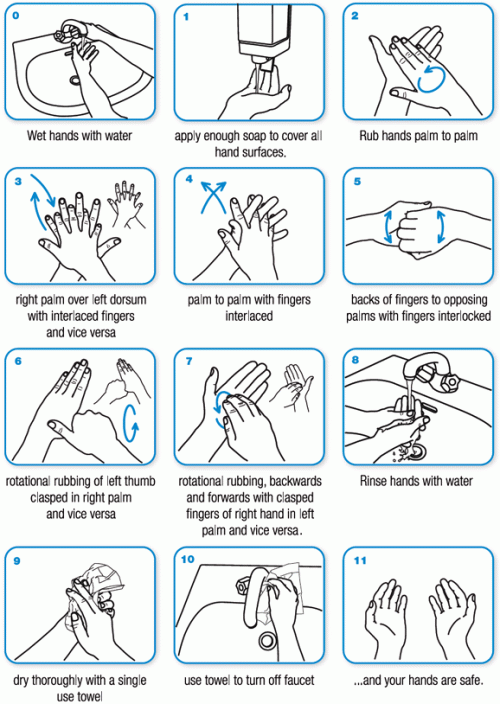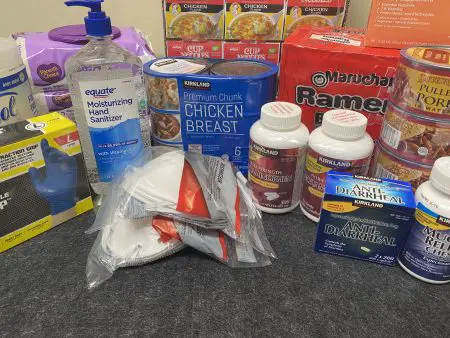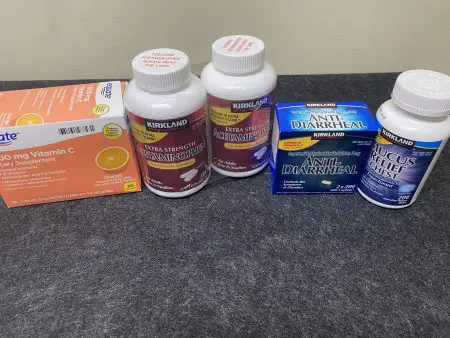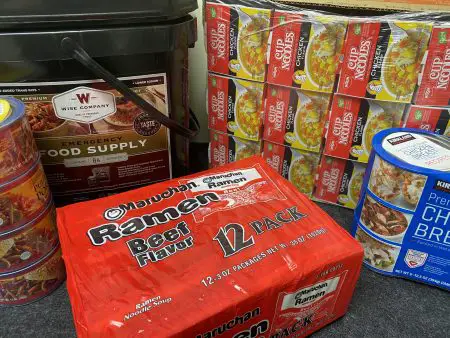How to Prepare for Quarantine
I’m writing this in the wake of the COVID-19 scare that’s currently spreading around the globe, but all of these steps will work equally as well for any situation that may cause you to have to want to quarantine in your home. Depending on how bad a certain disease gets you could even be forced to quarantine in your home.
Let’s look at why you would want to quarantine, the supplies needed, how to quarantine, and when it may be safe to come back out.
[wc_toggle title=“Table of Contents” padding=“” border_width=“” class=“” layout=“box”]
[/wc_toggle]
[wc_box color=“inverse” text_align=“left” margin_top=“” margin_bottom=“” class=“”]
Thanks for supporting Ready Lifestyle! We participate in the Amazon associates program and other affiliate programs. We earn a small commission on qualifying orders at no expense to you.
Preparing for a Quarantine
A quarantine is designed to separate sick (and possibly contagious) people from those people that aren’t sick. It’s one of the most effective ways to prevent the spread of disease but it’s also very restrictive, so it’s often only used as a last-ditch effort when nothing else is working.
This is especially true when you’re dealing with a highly contagious disease that has a long incubation period and like the Coronavirus. When a disease can be spread, even when you don’t show symptoms, quarantine is usually a good idea.
[wc_box color=“primary” text_align=“left” margin_top=“” margin_bottom=“” class=“”]
Download our home quarantine cheat-sheet here.
Additional Things to Consider About a Quarantine
Quarantine is obviously going to seriously change how you go about your daily life. With that change, there are some things that need to be considered.
If you have kids in school then you need to be prepared to make arrangements for them to keep up with their education from home. You can do this by contacting their school and getting assignments ahead of time or possibly even arrange for some kind of teleschool set-up. Kids will benefit from some kind of normalcy in their lives if they’re forced to quarantine.
You’re going to want to arrange to work from home if you can. If you work a job that doesn’t lend itself to working from home, then you’re going to potentially experience a loss of pay and even a loss of your job if you decide to quarantine yourself without being forced to by a government agency. It’s a tough call, but it’s one that you may be forced to make!
If you have a need for ongoing medical care, see if your doctor offers the option of telemedicine (e-health, telehealth, whatever you want to call it). This is where you can consult your physician remotely in the same way that you can by going into the office. If your doctor doesn’t offer the option, then there are a ton of places popping up on the internet that will prescribe medications and offer health advice via the internet.
When to Quarantine in Your Home
No one really wants to quarantine in their home, but there are some times when it’s the only thing that you can really do to protect yourself.
When to quarantine in your home:
- When you’ve been exposed to the disease and may be contagious
- When you don’t want to run the risk of getting exposed to the disease
Ultimately, deciding to self-quarantine is usually done as a way to prevent you from spreading the disease to others and not the other way around.
What to Stock for Quarantine
In order for a quarantine to be successful, you need to be able to stay inside for the entire time without exposing yourself to the outside world. This means that when you’re preparing for quarantine, you’re trying to store enough supplies to keep you going for as long as you’ll need to stay inside your house along with all of the things that you’ll need to implement your quarantine procedures.
Most of the items that you’ll need for a quarantine are similar to a shelter in place kit. If you’ve already built one, then the extra items that you need are going to be pretty minimal.
Quarantine kit inventory:
- 5-gallon bucket with trash bags and kitty litter - You can pack most of the items in the 5-gallon bucket and it will double as a toilet by lining it with a trash bag and pouring about an inch of kitty litter in the bottom.
- 1 gallon of water per person for as many days as you may need to quarantine - A case of bottled water is just over 3 gallons.
- non-perishable food for each person for the length of time that you’ll be quarantined for.
- Household chlorine bleach (unscented with no additives) - You can add 16 drops per gallon of water to disinfect it or mix 1 part bleach to 9 parts water to make a disinfectant cleaner.
- Pool shock (73% Calcium Hypochlorite and 70% available chlorine content) - Allows you to mix bleach at home and has a much longer shelf life than bottled bleach.
- Battery-powered or hand-crank NOAA weather radio
- Flashlight with extra batteries
- First aid kit
- Over the counter medication (see below for a full list)
- Thermometer
- Several N95 dust masks per person
- Disposable rubber gloves
- Clear goggles or protective glasses - Allows you to cover your eyes to prevent possible contamination by airborne particulates.
- Plastic sheeting and duct tape to seal around the plastic - Enough to seal all doors, and vents for an isolation room if needed.
- Surgical masks - For anyone in the house that may get sick.
- Heavy gauge garbage bags - For disposing of potentially contaminated waste.
- Anti-bacterial hand soap
- Clorox wipes
- Hand sanitizer - 60 - 95% alcohol
- Handheld spray bottles - For bleach disinfectant mix.
- 1-gallon sprayer (like this) - For disinfecting larger areas.
Additional items to add if your situation requires them:
- Diapers and formula
- Food and water for pets
- Can opener if you pack canned food
- Books, games, puzzles or other activities for children
- Prescription medications that will last you for the entire quarantine
Don’t forget to have enough shampoo, deodorant, toilet paper, toothpaste and other items that you use throughout the course of your day.
Over the Counter Medication
There are a ton of over the counter (OTC) medications that may help boost your immune system so you don’t get sick and make your life a lot less miserable if you do get sick.
The top immune system boosting OTC medications are Emergen-C and Airborne. They’re both very similar and come in drink mix, chewable tablets, and gummy forms. They basically take all of the things that are known to increase the efficiency of your immune system and package them into one place so you don’t need to grab each ingredient individually.
Using one of these two products is pretty much a necessity in my mind. Keeping your immune system powered up is really important, especially if you’re already immune system compromised or you do things that lower your immune system (like drinking heavily or smoking cigarettes).
There are two different ways to go about treating a cough with OTC meds. You can either use a cough suppressant (usually has the active ingredient dextromethorphan) or by using an expectorant (guaifenesin).
Cough suppressants may seem like the way to go because they keep you from coughing and can soothe your throat and give you some relief from a chest cold and infection symptoms.
Expectorants are usually the way to go in my opinion. They thin the mucus in your and allow you to get it out of your body. It may be miserable to cough non-stop, but you’re better off getting the mucus out of your body.
Pain relievers are readily available OTC. I’d suggest stocking up on either Tylenol or an NSAID of some kind because they both help with aches and pains and can lower a fever.
Food Items for Quarantine
The types of food that you should store for a quarantine should be relatively shelf-stable and not prone to spoiling or going bad quickly.
If you don’t cook on a regular basis then you should really look over the things that you have in the pantry and make sure that you have the things required to make simple baked goods. Cooking will also help keep you occupied and distract you from the fact that you’re stuck in the house.
Food items to stock for quarantine:
- Canned soups, meat, vegetables, and other foods
- Pasta, rice, beans, flour, baking items
- Crackers
- Spices to keep things from getting boring
- Comfort foods (Chips, Cookies, etc.)
- Juice
- Softdrinks
- Coffee
- Powdered milk
- Oatmeal
- Meal replacement bars
- Nuts
Power should still be up (at least for most of the day) while you’re quarantined, so you can still rely on your fridge and freezer to keep foods fresh. On top of buying frozen meals from the store, there are also a ton of foods that freeze well and will keep through a prolonged quarantine.
Food that freezes well:
- Meats
- Casseroles
- Soup, broth, and sauces
- Muffins, bread, dough
- Applesauce
- Butter, cheese, cream cheese, and sour cream
- Eggs
- Fresh herbs
- Citrus, grapes
- Milk
Water for Quarantine
You should already be storing water as far as I’m concerned but, water in quarantine isn’t likely to get turned off. You probably don’t have to go crazy with the amount of water that you store if you’re not already doing it as part of your normal preps.
Even though your water will most likely be fine to drink, I still suggest picking up a few cases of water for each person in your family on the off chance that something really crazy happens.
Quarantine Procedures
The exact procedures that you take to quarantine yourself in your home aren’t very difficult. They mostly have to do with the way that you sanitize things throughout the day and the ways that you prevent your exposure to other people.
There’s just no need to try to seal your whole home from outside air or anything crazy like that!
Most diseases that would cause a quarantine are spread through contact with infected people, by inhaling respiratory droplets from coughing or sneezing and touching surfaces that have been infected and then touching your eyes, nose or mouth. This means that almost any disease will need you to be in close proximity to an infected person or to touch a surface that infected and then transfer it to yourself. The disease isn’t going to be climbing through the crack under your door.
Daily Activities
The primary thing that will change with quarantine is your day to day activity. Just about everything is going to have to change!
Only leave your home to get emergency medical care. This is the basic idea of quarantine, but it needs to be said.
Wash your hands often and whenever you do anything that may get them contaminated like going to the bathroom. Wah your hands before touching your face, eyes or mouth. This is the BEST way to keep yourself healthy.
Effective hand washing is a deliberate action! You should be thinking about cleaning your hands and making sure that you scrub all areas of your hands. Don’t just get them wet and smear some soap on them. That’s not enough!

Using hand sanitizer is okay but it’s not as effective as washing your hands. If you have any kind of visible bodily fluids or other dirt on your hands then you need to wash them with soap or water.
Using bleach to disinfect hard surfaces is a great way to keep them free of diseases. The CDC recommends using 1 cup of bleach to 5 gallons of water.
Wash the area with soap and water, then clean the surface with the bleach mixture and allow it to air dry. If the surface is rough then you should scrub it with a hard-bristled brush and let it air dry.
Other things to do as you go about your day:
- Cover your cough or sneeze. Clean your hands with hand sanitizer or by washing them with soap and water.
- Throw used tissues or paper towels in a lined trash can after use.
- Don’t share glasses, dishes, utensils or other personal items with other family members.
- Disinfect all surfaces that get touched often with bleach at least daily. This includes doorknobs, keyboards, phones, handles, tablets, and bedside tables.
- Disinfect all toilets or other items that may get bodily fluids on them after each use.
- Open curtains and blinds to let sunlight in during the day. UV light kills microorganisms and sunlight can help with depression.
Everything is about preventing the spread of any disease as you go about your day.
Dealing with Sick Family Members
Dealing with sick family members is going to be one of the most difficult parts of any kind of significant outbreak. The key is going to be to treat them as best as you can while not contracting the disease yourself.
When you first decide to quarantine in your home, you should set up an isolation room if you can. An extra bedroom is a great place for this. The isolation room is going to be where a sick member of your family goes until they’re past the point of being contagious.
When you’re dealing with sick family members they should wear a surgical mask and you should wear an N95 mask and goggles or a face shield. Also, stay at least 6 feet away from them unless you have to get closer. If you need to come in contact with any surfaces that have their bodily fluids on them then you should wear rubber gloves.
After you leave the room, throw away disposable masks and gloves. Do not reuse them. If you’re using reusable protective gear, then you need to sanitize them according to the manufacturer’s suggestion. If you don’t have guidance, then use bleach to sanitize them.
Remove protective gear in this order:
- Gloves
- Wash hands
- Face mask
- Wash hands
- Eye protection
- Wash hands
Sick family members should also be kept away from animals. There’s very little chance that the disease will spread to your pets, but it’s a possibility.
Pets are also much more difficult to sanitize and control. Imagine your dog running all over the house after jumping on a sick family member. How could you possibly be sure that the disease wasn’t spread everywhere?
Making an Isolation Room
An isolation room is where you will place any sick family members until they’re better. The idea is to keep them separated from the rest of the family so no one else gets sick.
If you can also have a dedicated bathroom and shower for them then that’s even better.
The sick family member should do as much as they can to not spread the disease to the surfaces of the room even though they’ll be in your isolation room. This means constantly cleaning their hands, sanitizing surfaces daily with a bleach solution, etc. the same way that everyone else is doing in the rest of the house.
There aren’t a lot of steps that need to be taken to prepare the room, but I would do the following before anyone was sick:
- Cover any central air return vents in the room with plastic (or have some tape and plastic nearby). This is probably overkill but blocking the return vent will prevent most of the air from your isolation room getting sucked into the central air system and spread through the house.
- Have surgical masks, heavy-gauge trash bags, hand soap, hand sanitizer, and bleach pre-staged in the room.
Interacting with Outside People
Don’t open the door for anyone! Unless the police are at your front door and threatening to kick it in, keep your door closed and don’t interact with anyone that comes to your door.
You can speak to them through the door, or even better, talk to them through a smart doorbell like the Ring. It’s times like these that I’m happy that I installed one about a year ago.
Breaking Quarantine and Coming Out
It’s difficult to know exactly when it’s okay to drop your quarantine and join the rest of the world again. If there is an all-clear given by authorities, it’s probably okay to assume that it’s okay. Otherwise, you’ll need to use your best judgment based on the life cycle of the disease as you know it.
Things to consider when determining when to break quarantine:
- Any information being passed by government officials (A drop in infection rates, “All clear” announcements, etc.)
- The potential incubation period of the disease (The time where people may be infected but not showing symptoms)
- How long the disease lasts once you’re showing symptoms
- The action of other people that live by you (Are they coming outside, are there obviously sick people in the area, are other people going back to work/school, etc.)
No matter what, I wouldn’t be the first one out the door running to Walmart. Plan on an extra day or two in the house after most other people have started going out again!
Conclusion
If you’re forced to self-quarantine in your home, it’s going to be stressful and you’re most likely going to be worrying about all kinds of things. By preparing ahead of time, at least you don’t need to worry about fighting the rush at the stores for food, water, and other supplies!
Hopefully, this article helps you understand what’s needed in the event that you do have to quarantine in your house and makes things a little easier for you and your family. Good luck out there!
The article Step-by-Step: How to Prepare for Quarantine (with Cheat-Sheet) was first published to: ready lifestyle
Step-by-Step: How to Prepare for Quarantine (with Cheat-Sheet) published first on https://readylifesytle.tumblr.com



Comments
Post a Comment